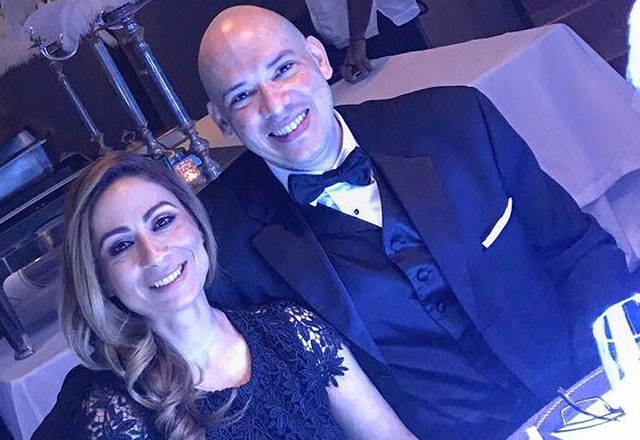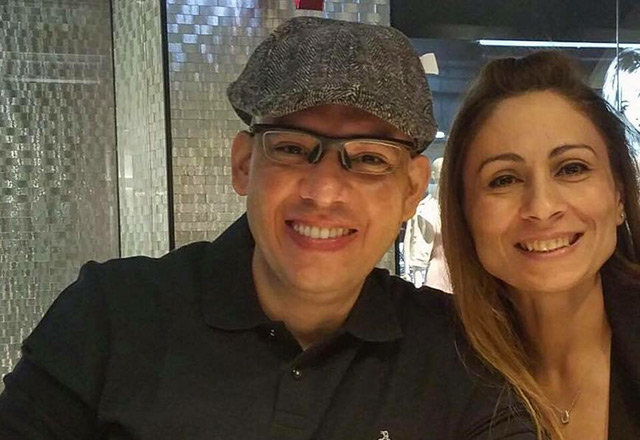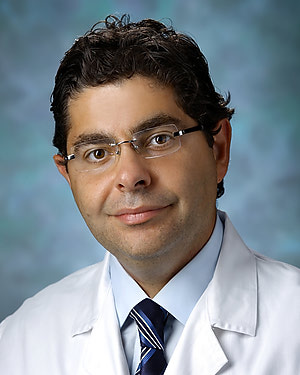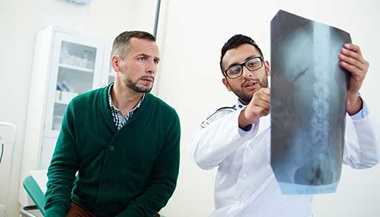Patient Story
Thoracic Disc Herniation: Pedro's Story

Pedro Gil was hardly able to move before he came to The Johns Hopkins Hospital for treatment in 2017. Gil, a resident of the Dominican Republic, had struggled with a thoracic disc herniation for 10 years. His herniated disc had calcified, turning to bone, and it pressed on his spinal cord to produce excruciating pain, weakness, numbness and even paralysis. Doctors told him his condition was so severe he might die. He would never walk again.
At Johns Hopkins, the message was different.
“Dr. Bydon gave my case a more positive diagnosis,” says Gil, recalling his first visit to Johns Hopkins neurosurgeon Ali Bydon. Gil had already tried years of physical therapy, massage and other treatments, plus an emergency surgery in his home country, the Dominican Republic. Gil’s injury was so precarious the Dominican surgeons abandoned their attempt mid-procedure, afraid of damaging his spinal cord.
New Hope for Rare Thoracic Disc Herniation
Gil’s condition is rare and difficult to treat, says Bydon. The thoracic area stretches from the bottom of a patient’s neck to the top of the back, just behind the lungs. The ribcage completely surrounds the affected area, generally making it more stable than the neck or lower back.
“You have millions of people who herniate discs in the neck or lower back, but a herniation in thoracic spine area is exceedingly rare,” Bydon explains. A herniation like Gil’s occurs in one out of every one million people per year—the likelihood of the injury is, quite literally, one in a million.
At Johns Hopkins, Gil found he had come to the right place. The more often a surgeon performs a procedure, the better. Most surgeons have only seen one or two patients like Gil, but Johns Hopkins draws patients from all over the country and world. Bydon and his neurosurgical colleagues have performed over 70 procedures on thoracic disc herniations in the past 12 years.
A Devastating Diagnosis
When Bydon met his patient, he saw a young man whose uncontrolled back pain and severe spinal cord injury confined him to a wheelchair. During their first appointment, Gil was crying.
A disc herniation is a problem with the disc-shaped cushions between the vertebrae or individual bones of the spine. The discs have a tough exterior with a softer center—a herniation occurs when the soft center of the disc bulges out into the spinal canal. The spinal canal houses the delicate spinal cord. Gil’s herniated disc calcified over time, creating a piece of bone that pressed painfully against his delicate spinal cord.
The calcification made Gil’s condition particularly complex, Bydon explains. “Unlike a soft piece of disc where one can tease it easier during surgery, a calcified fragment must be drilled, a fraction of an inch away from the spinal cord—a fraction away from complete paralysis,” he says. “Often, the fragment is stuck to the spinal cord or the covering of the spinal cord. Removal can lead to overmanipulation of the spinal cord—and paralysis.”
Other U.S. surgeons had told Gil they would approach his surgery via two separate operations. The first, an eight-hour procedure, would begin in the front of his body, a transthoracic approach in which surgeons enter through the chest cavity housing the lungs. This would create a pneumothorax, introducing air into the chest cavity and deflating the lungs to reach the problem area of his spine. In a second eight-hour operation, surgeons would enter through his back, stabilizing the back and decompress the spinal cord. The two separate procedures would involve two days in the operating room and a total of 16 hours under anesthesia. Gil was scared.
“It’s a high-risk operation,” Bydon says. “It is doable, but it does carry with it significant risks. In general, the less time that is spent in the operating room, the better. If we can get away with one operation, that may be a good thing.”
A Delicate Approach
Bydon envisioned another, lower risk solution. “I said, ‘I can see where those surgeons are coming from, but I have a feeling we may be able to do that with one operation only, sparing his lungs and vessels all together,’” Bydon recalls.
The surgery in Sept. 2017 was a success. “We were able to decompress it beautifully—in just four hours,” Bydon says. “We drilled the spine extremely tediously under a microscope, leaving an eggshell layer of bone against the spinal cord. Once I removed that big calcified mass that was jamming the spinal cord, it was just that eggshell layer left between me and the spinal cord—micromillimeters.”
Advanced intraoperative imaging and neuromonitoring allowed Bydon to operate with precision and confidence. The surgeon is one part of the team and advanced technology is necessary to ensure success in complex procedures, Bydon says.
“You want your neurosurgeon to have done a lot of these cases, but you also need to be in a hospital where the nursing staff, operating room staff and ICU staff are accustomed to these cases,” he explains. “You need a talented anesthesiologist and neurologists who monitor the signals from the nerves in the legs. You need intraoperative CAT scans to ensure adequate resection of the calcified disc and decompression of the spinal cord. You need a neurosurgeon who is not going to shy away from being a little more aggressive, but is armed with experience and judgment. You need that talent and experience in your operative neurosurgeon to ensure a safe landing.”
Experience and Technology — A Lifesaving Combination
The neurosurgery team at Johns Hopkins is experienced in many complex spinal surgeries such as Gil’s. “Our neurosurgeons here do everything related to spine, Bydon says. “We have a vast surgical experience in treating patients with conditions such as arthritic lumbar stenosis, lumbar spondylolisthesis, lumbar malalignment of bones and discs, degenerative scoliosis, compression on the spinal cord, cervical stenosis, disc herniations. We work on everything from oncology cases to degenerative diseases that we commonly see with aging, to even very rare conditions such as disc herniations on the thoracic spine.”
“Our team is extremely talented and experienced with over 100 years’ collective experience of operating on the spine,” Bydon adds.
A year and a half after surgery, Gil’s prognosis is good. “He’s made a remarkable recovery,” Bydon says. “He is not 100 percent, because the spinal cord had been injured years before we got there. He’s gone from a wheelchair to a cane, and his neurological problems are significantly less.”
Gil, who thought he would never walk again, says he is delighted with his progress. “It’s much better,” he says. “I still feel pain, but it is definitely less pain. I still have some minor limitations, but I’m able to do my usual activities.”
“I felt extremely well after waking up from anesthesia,” Gil says. Dr. Bydon “is an excellent physician. I don’t think there could have been a better doctor for my case.”

A Grateful Patient
Gil agrees with Bydon that his treatment was successful because of the team involved—from his neurosurgeon to his care coordinator, Martha Martinez, who works with patients from all over the globe through her role with Johns Hopkins Medicine International. Care coordinators like Martinez shepherd international patients through every step of their time at Johns Hopkins, helping arrange appointments, coordinating lodging and transportation for the family, ensuring the patient and his family understand the diagnosis and treatment plan.
“The staff was extremely friendly, always with a smile,” Gil says. “The nurses, technicians, doctors and staff all treated me like a friend, not a patient. It was a lovely experience.”
Gil returns to Johns Hopkins for check-ups every now and then. He has already recommended the hospital to two friends who have since traveled to Baltimore for treatment.
“There are no words in the world to describe how grateful and lucky I am to have found Dr. Bydon,” he says.
Pedro's Neurosurgeon
The Neurosurgical Spine Center
The Johns Hopkins Neurosurgical Spine Center is dedicated to relieving pain, restoring function and implementing advanced treatments, including minimally invasive spine procedures, for a wide range of neurologic conditions affecting the spine and spinal cord.





